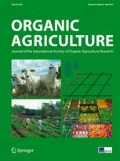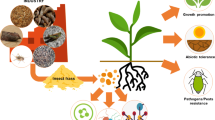Abstract
In many perennial fruit systems, unharvested fruit left on the orchard floor can exacerbate insect pest problems by harboring insect pest larvae. Apple, cherry, and pear growers in the northeastern USA must control a number of challenging insect pests, including plum curculio Conotrachelus nenuphar (Herbst), codling moth (Cydia pomonella (L.)), and oriental fruit moth Grapholita molesta (Busck). Integrating livestock into tree fruit systems for the purpose of consuming leftover fruit may provide insect and weed pest management services. We rotationally grazed pigs after harvest in certified organic apple, cherry, and pear orchards to determine the amount of fruit the hogs would consume from the orchard floor, the impact hogs would have on orchard ground cover, and what pest insects the hogs could potentially suppress by consuming leftover fruit. The pigs consumed 100 % of leftover fruit in all three orchard types. Pigs significantly increased the amount of bare ground and decreased the amount of grass in all three orchard types. Both codling moth and oriental fruit moth larvae were found to be present in leftover apples and pears collected from the ground, whereas no pest insects were found in leftover cherries. Plum curculio fruit damage was significantly lower in grazed cherry plots, and codling moth/oriental fruit moth fruit damage was significantly lower in grazed pear plots following the first year of the study. Fruit damage data could not be collected following the second year of the study due to total crop loss.





Similar content being viewed by others
References
Balfour EB (1975) The living soil and the Haughley experiment. Palgrave MacMillan, London, p 383
Center for Food Safety and Applied Nutrition (1998) Guidance for industry: guide to minimize microbial food safety hazards for fruits and vegetables. Washington: U.S. Department of Health and Human Services, Food and Drug Administration. http://www.fda.gov/downloads/Food/GuidanceComplianceRegulatoryInformation/GuidanceDocuments/ProduceandPlanProducts/UCM169112.pdf . Accessed May 4, 2011
Chee YK, Faiz A (1991) Sheep grazing reduces chemical weed control in rubber. In: Shelton HM, Stur WW (eds) Forages for plantation crops. ACIAR Proceedings 32. ACIAR, Canberra, Australia, pp 120–123
Clark MS, Gage SH (1996) Effects of free-range chickens and geese on insect pests and weeds in an agroecosystem. Am J Altern Agric 11:39–47
Dastgheib F, Frampton C (2000) Weed management practices in apple orchards and vineyards in the South Island of New Zealand. NZ J Crop and Hortic Sci 28:53–58
Daubenmire RF (1959) A canopy coverage method of vegetation analysis. Northwest Sci 33:43–64
Development Core Team R (2011) R: a language and environment for statistical computing. R Foundation for Statistical Computing, Vienna, Austria
Hatch PJ (1998) The fruits and trees of Monticello: Thomas Jefferson and the origins of American horticulture. University of Virginia Press, Charlottesville, p 222
Hayashi K, Ikeda K, Ueda A, Fumita T, Etoh T, Gotoh T (2006) Short-term response of vegetation to cattle grazing in an abandoned mandarin orchard in southwestern Japan. Asian-Aust J Anim Sci 19(4):514–520
Hilimire K (2011) Integrated crop/livestock agriculture in the United States: a review. J Sustain Agric 35(4):376–393
Howard A (1972) An agricultural testament. Rodale Press, Emmaus, p 253
Judd GJR, Gardiner MGT, Thomson DR (1997) Control of codling moth in organically-managed apple orchards by combining pheromone-mediated disruption, post-harvest fruit removal and tree banding. Entomol Exp et Appl 83:137–146
Knudson WA (2007) The organic food market. Strategic Marketing Institute Working Paper, Michigan Agricultural Experiment Station, East Lansing. http://expeng.anr.msu.edu/uploads/files/39/organicfood.pdf. Accessed December 22, 2011
Lafleur G, Hill SB, Vincent C (1987) Fall migration, hibernation site selection, and associated winter mortality of plum curculio (Coleoptera: Curculionidae) in a Quebec apple orchard. J Econ Entomol 80(6):1152–1172
MacLellan CR (1960) Cocooning behaviour of overwintering codling moth larvae. Can Entomol 92(6):469–479
Merwin IA, Stiles WC (1994) Orchard groundcover management impacts on apple tree growth and yield, and nutrient availability and uptake. J Am Soc Hortic Sci 119:209–215
Miller SS, Glenn DM (1985) Influence of various rates of Ca (NO3)2 fertilizer and soil management on young apple trees. J Am Soc Hortic Sci 110:237–243
National Organic Program. (2011) Guidance: processed animal manure in organic crop production. In: The Program Handbook. U.S. Department of Agriculture, Agricultural Marketing Service, Washington. http://www.ams.usda.gov/AMSv1.0/getfile?dDocName=STELPRDC5087120. Accessed May 4, 2011
Neilsen GH, Hogue EJ (2000) Comparison of white clover and mixed sodgrass as orchard floor vegetation. Can J Plant Sci 80:617–622
Nunn L, Embree CG, Hebb D, Bishop SD, Nichols D (2007) Rotationally grazing hogs for orchard floor management in organic apple orchards. Acta Hort (ISHS) 737:71–78
Oliveira MT, Merwin IA (2001) Soil physical conditions in a New York orchard after eight years under different groundcover management systems. Plant Soil 234:233–237
Organic Trade Association (2010) U.S. Organic industry overview. Organic Trade Association, Greenfield. http://www.ota.com/pics/documents/2010OrganicIndustrySurveySummary.pdf. Accessed May 4, 2011
Peck GM, Merwin IA, Thies JE, Schindelbeck RR, Brown MG (2011) Soil properties change during the transition to integrated and organic apple production in a New York orchard. Appl Soil Ecol 48:18–30
Peterson DL, Whiting MD, Wolford SD (2003) Fresh-market quality tree fruit harvester-part I: sweet cherry. Appl Eng Agric 19(5):539–543
Pettit RH (1932) The oriental peach worm. Michigan State University Extension, Bulletin, 75
Rifai MN, Astatkie T, Lacko-Bartosova M, Gadus J (2002) Effect of two different thermal units and three types of mulch on weeds in apple orchards. J Environ Eng Sci 1:331–338
Russelle MP, Entz MH, Franzluebbers AJ (2007) Reconsidering integrated crop-livestock systems in North America. Agron J 99:325–334
Schupp JR, McCue JJ (1996) Effect of five weed control methods on growth and fruiting of ‘McIntosh’/M.7 apple trees. J Tree Fruit Prod 1(1):1–14
Shribbs JM, Skroch WA (1986) Influence of 12 ground cover systems on young ‘Smoothee Golden Delicious’ apple trees: I. Growth J Am Soc Hortic Sci 111:525–528
Smith EH (1957) A method for rearing the plum curculio under laboratory conditions including some biological observations. J Econ Entomol 50:187–190
Solomon ME, Glen DM, Kendall DA, Milsom NF (1976) Predation of overwintering larvae of codling moth (Cydia pomonella (L.)) by birds. J Appl Ecol 13(2):341–351
Steed JL (1978) The automatic hoe. Pecan Q 12(2):31–32
Tedders WL (1983) Insect management in deciduous orchard ecosystems: habitat manipulation. Environ Manag 7(1):29–34
Thomas WP, Burnip GM (1993) Lepidopterous insect pests and beneficials: the influence of understory. In: McCarthy TP, Daly DJ, Burnip GM (eds) Proceedings of the Biological Apple Production Seminar. HortResearch, Palmerston North, p 78
U.S. Department of Agriculture (2004) 2002 Census of Agriculture. National Agricultural Statistics Service, Washington. http://www.agcensus.usda.gov/Publications/2002/USVolume104.pdf. Accessed May 4, 2011
U.S. Department of Agriculture (2010) 2008 Organic Production Survey. In: 2007 Census of Agriculture. National Agricultural Statistics Service, Washington http://www.agcensus.usda.gov/Publications/2007/Online_Highlights/Organics/ORGANICS.pdf. Accessed May 4, 2011
Walsh BD, Riley CV (1868) Hogs vs Bugs Am Entomol 1(1):3
Waugh RA (1909) The American apple orchard. Orange Judd Company, New York, p 107
Weems HV Jr (1972) Cherry fruit fly, cherry maggot, Rhagoletis cingulata (Loew) (Insecta: Diptera: Tephritidae). Entomol Circ 116
Wilson LM, Hardesty LH (2006) Chapter 11: targeted grazing with sheep and goats in orchard settings. In: Launchbaugh K et al (eds) Targeted grazing: a natural approach to vegetation management and landscape enhancement. American Sheep Industry Association, Centennial, pp 99–106
Wise JC, Schoenborn K, Isaacs R (2004) Control of cranberry fruitworm and cherry fruitworm. Arthropod Manag Tests 29
Wise JC, Kim K, Hoffmann EJ, Vandervoort C, Gökçe A, Whalon ME (2007) Novel life stage targets against plum curculio, Conotrachelus nenuphar (Herbst), in apple integrated pest management. Pest Manag Sci 63(8):737–742
Acknowledgments
We would like to thank Dr. David Epstein and Jim Koan for developing the concept of integrated hog and orchard production in Michigan. We would like to thank the growers Gene Garthe, Jess Piskor, and Abra Berens for their cooperation and all of the time and effort they dedicated to this project. We would like to thank Emily Pochubay, Philip Kouvariaris, and Kristy Morell for helping with fieldwork and data collection. We would also like to thank Emily Pochubay for her assistance with statistical analyses in R. We would like to thank Peter McGhee and Pete Nelson for their editorial assistance. We would like to thank the CERES Trust for the Organic Research Initiative Graduate Student Grants for project funding.
Author information
Authors and Affiliations
Corresponding author
Rights and permissions
About this article
Cite this article
Buehrer, K.A., Grieshop, M.J. Postharvest grazing of hogs in organic fruit orchards for weed, fruit, and insect pest management. Org. Agr. 4, 223–232 (2014). https://doi.org/10.1007/s13165-014-0076-0
Received:
Accepted:
Published:
Issue Date:
DOI: https://doi.org/10.1007/s13165-014-0076-0




